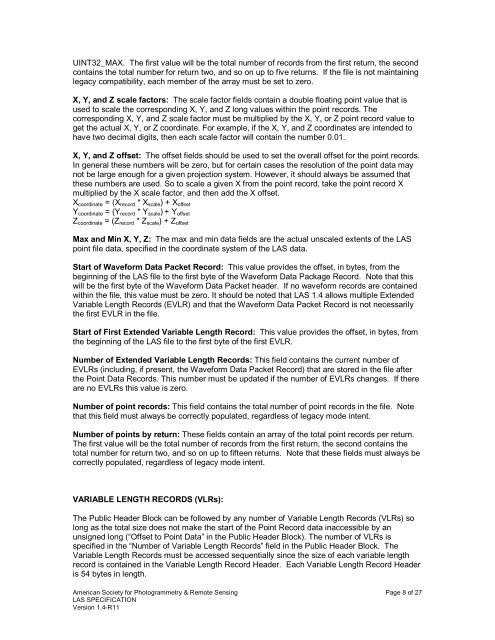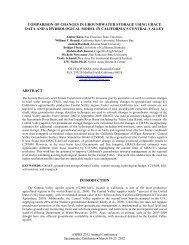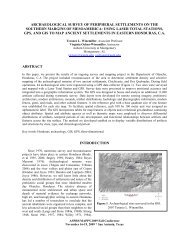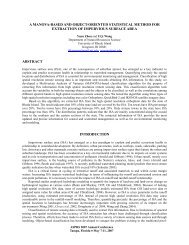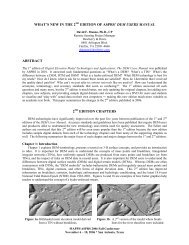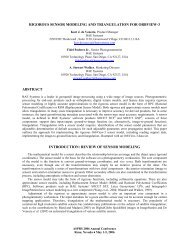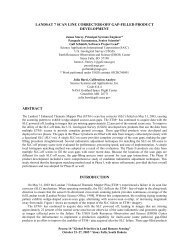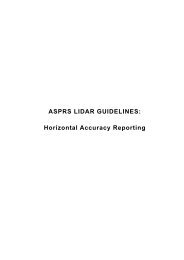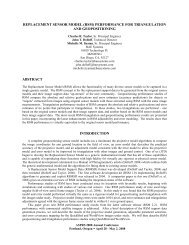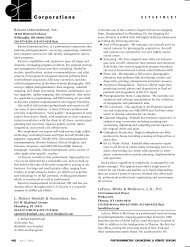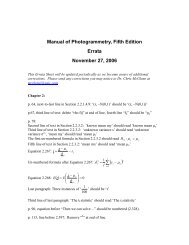LAS SPECIFICATION VERSION 1.4 – R11 - asprs
LAS SPECIFICATION VERSION 1.4 – R11 - asprs
LAS SPECIFICATION VERSION 1.4 – R11 - asprs
Create successful ePaper yourself
Turn your PDF publications into a flip-book with our unique Google optimized e-Paper software.
UINT32_MAX. The first value will be the total number of records from the first return, the second<br />
contains the total number for return two, and so on up to five returns. If the file is not maintaining<br />
legacy compatibility, each member of the array must be set to zero.<br />
X, Y, and Z scale factors: The scale factor fields contain a double floating point value that is<br />
used to scale the corresponding X, Y, and Z long values within the point records. The<br />
corresponding X, Y, and Z scale factor must be multiplied by the X, Y, or Z point record value to<br />
get the actual X, Y, or Z coordinate. For example, if the X, Y, and Z coordinates are intended to<br />
have two decimal digits, then each scale factor will contain the number 0.01.<br />
X, Y, and Z offset: The offset fields should be used to set the overall offset for the point records.<br />
In general these numbers will be zero, but for certain cases the resolution of the point data may<br />
not be large enough for a given projection system. However, it should always be assumed that<br />
these numbers are used. So to scale a given X from the point record, take the point record X<br />
multiplied by the X scale factor, and then add the X offset.<br />
Xcoordinate = (Xrecord * Xscale) + Xoffset<br />
Ycoordinate = (Yrecord * Yscale) + Yoffset<br />
Zcoordinate = (Zrecord * Zscale) + Zoffset<br />
Max and Min X, Y, Z: The max and min data fields are the actual unscaled extents of the <strong>LAS</strong><br />
point file data, specified in the coordinate system of the <strong>LAS</strong> data.<br />
Start of Waveform Data Packet Record: This value provides the offset, in bytes, from the<br />
beginning of the <strong>LAS</strong> file to the first byte of the Waveform Data Package Record. Note that this<br />
will be the first byte of the Waveform Data Packet header. If no waveform records are contained<br />
within the file, this value must be zero. It should be noted that <strong>LAS</strong> <strong>1.4</strong> allows multiple Extended<br />
Variable Length Records (EVLR) and that the Waveform Data Packet Record is not necessarily<br />
the first EVLR in the file.<br />
Start of First Extended Variable Length Record: This value provides the offset, in bytes, from<br />
the beginning of the <strong>LAS</strong> file to the first byte of the first EVLR.<br />
Number of Extended Variable Length Records: This field contains the current number of<br />
EVLRs (including, if present, the Waveform Data Packet Record) that are stored in the file after<br />
the Point Data Records. This number must be updated if the number of EVLRs changes. If there<br />
are no EVLRs this value is zero.<br />
Number of point records: This field contains the total number of point records in the file. Note<br />
that this field must always be correctly populated, regardless of legacy mode intent.<br />
Number of points by return: These fields contain an array of the total point records per return.<br />
The first value will be the total number of records from the first return, the second contains the<br />
total number for return two, and so on up to fifteen returns. Note that these fields must always be<br />
correctly populated, regardless of legacy mode intent.<br />
VARIABLE LENGTH RECORDS (VLRs):<br />
The Public Header Block can be followed by any number of Variable Length Records (VLRs) so<br />
long as the total size does not make the start of the Point Record data inaccessible by an<br />
unsigned long (“Offset to Point Data” in the Public Header Block). The number of VLRs is<br />
specified in the “Number of Variable Length Records” field in the Public Header Block. The<br />
Variable Length Records must be accessed sequentially since the size of each variable length<br />
record is contained in the Variable Length Record Header. Each Variable Length Record Header<br />
is 54 bytes in length.<br />
American Society for Photogrammetry & Remote Sensing Page 8 of 27<br />
<strong>LAS</strong> <strong>SPECIFICATION</strong><br />
Version <strong>1.4</strong>-<strong>R11</strong>


